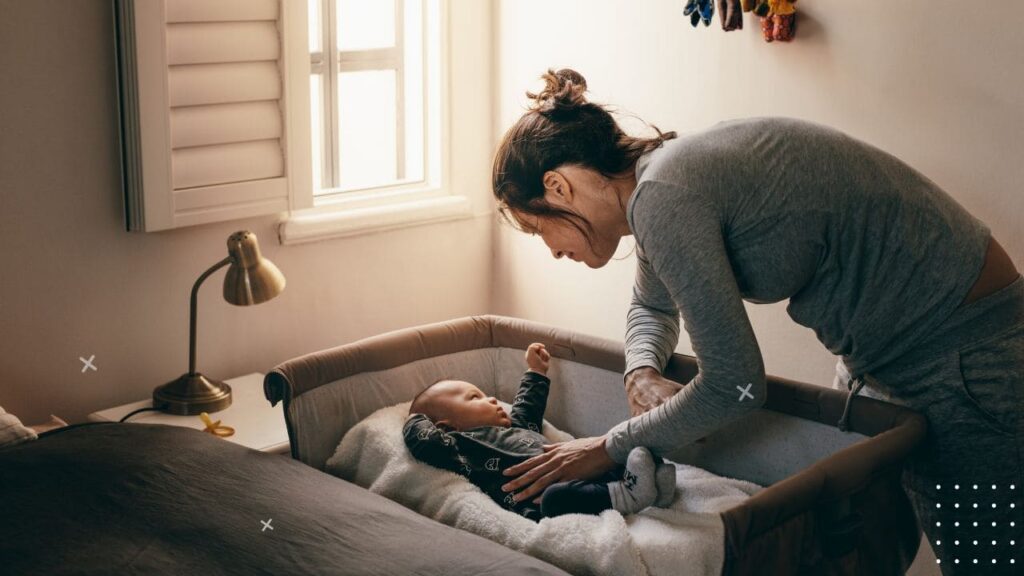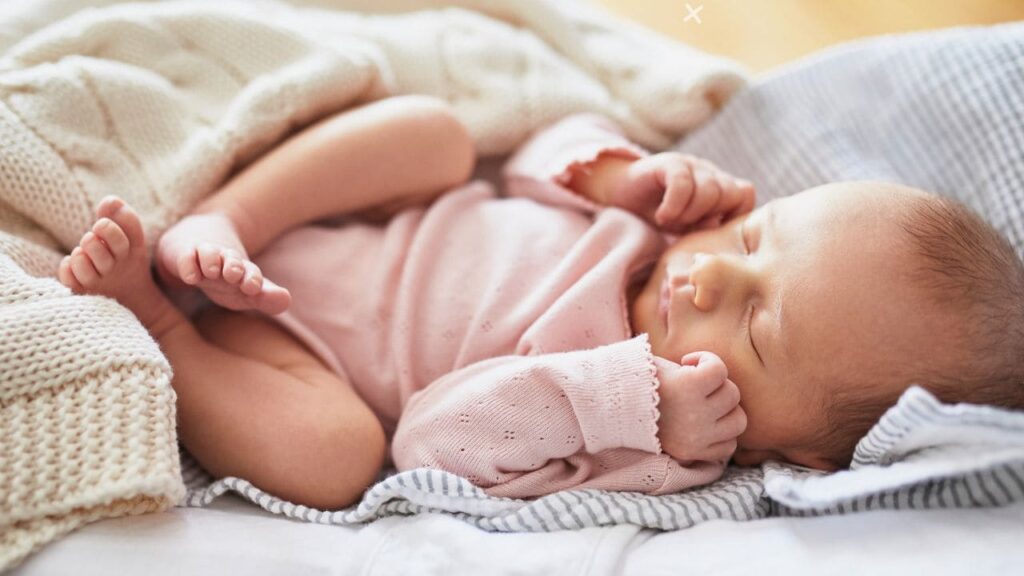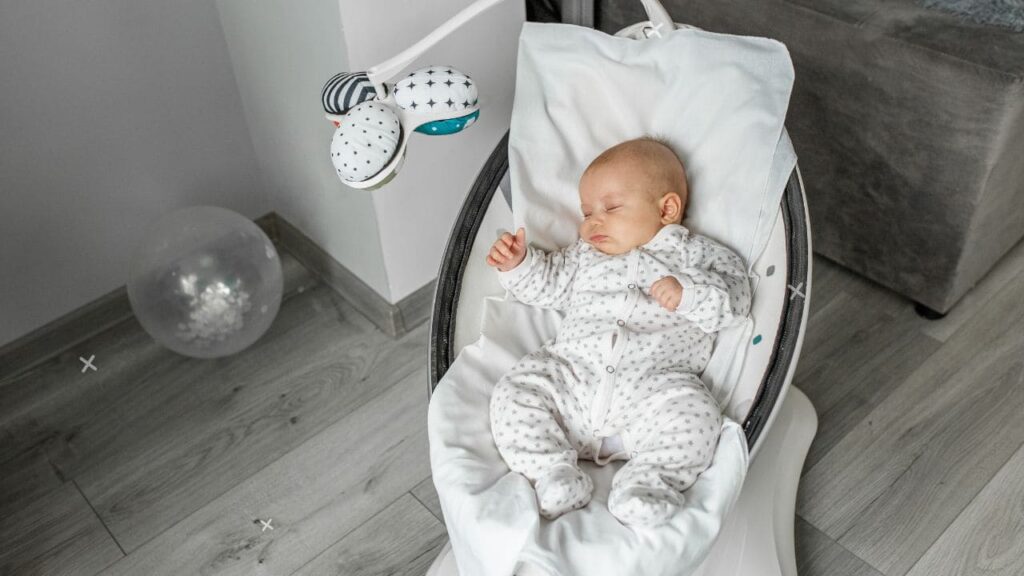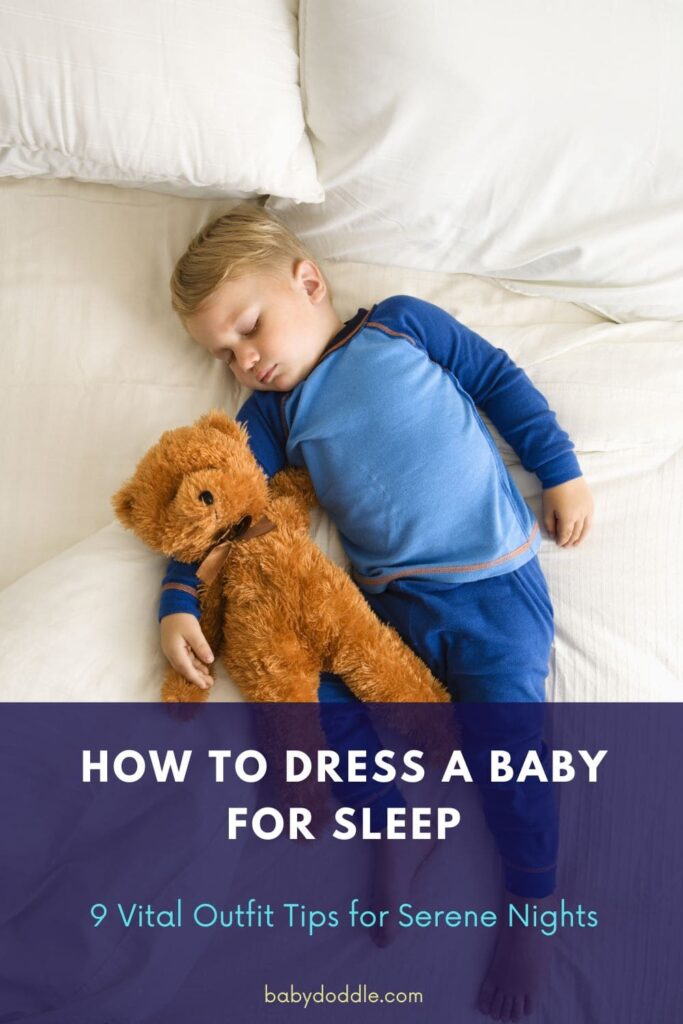As a new parent, figuring out how to dress a baby for sleep during those long nighttime stretches can be a real challenge. After all, babies can’t tell you if they are too hot or cold! Having the right sleep outfit can make all the difference in your little one getting quality, uninterrupted shut-eye.
In this blog post, we will cover 9 vital tips to keep in mind when choosing an outfit for your baby to snooze in comfortably all night long. From layering for just the right temperature to the best fabrics for breathability, read on for a thorough guide on how to dress your baby for sleep and ensure a peaceful slumber.

Why Proper Sleepwear Matters
When dressing a baby for bed, it’s important not to just throw on any cute outfit lying around. Their sleep clothing serves key functions for safety and comfort. The right baby sleep outfit:
- Regulates Body Temperature: Babies have difficulty regulating their body heat. Proper sleep attire helps them stay nice and cozy—not too hot and not too cold.
- Prevents Overheating: Overbundled babies struggle to lose excess heat and may grow sweaty or restless. Light, breathable clothing helps release heat.
- Allows Movement: Babies start moving almost from day one. Their sleep outfit shouldn’t be restrictive or dangerous.
- Stays Secure: A well-fitted sleep garment ensures babies don’t wake up with loose bedding covering their faces.
Keeping these considerations in mind will lead to better sleep for the baby which means more rest for you too! Assess your baby’s needs, choose suitable fabrics/styles, adjust the temperature, and check outfit fit routinely.
Next Steps: Take note of your baby’s sleep environment, movements, and any overheating/chilling overnight to determine any outfit changes needed for their maximum comfort and safety.
Choose Breathable Fabrics
One key factor in proper sleepwear is the type of fabric it’s made from. Natural fibers like cotton and bamboo rayon are very soft and promote air circulation to prevent overheating.
Here are great fabric options for baby PJs:
- Cotton: A lightweight cotton baby bodysuit or pajamas allow skin to breathe and moisture to evaporate. Cotton is very soft, flexible, and widely available.
- Bamboo Rayon: Made from bamboo pulp, bamboo fabric is silky soft and exceptionally breathable— even more so than cotton. It resists odors too!
- Modal: Often blended with cotton or other fibers, modal is semi-synthetic but very breathable and moisture-wicking.
- Linen: A durable, lightweight woven fabric made from flax fibers, linen excels at absorbing moisture and allowing ventilation. Blends well with cotton.
While adorable flannel jammies seem super cozy, they may cause the baby to sweat. Stick with light, breathable fabrics so air can circulate and excess heat can escape through the night. Natural fibers work best!
Next step: Choose cotton, bamboo rayon, modal, linen, or blends of these fabrics for your baby’s nighttime outfit. Check clothing tags to verify what the baby’s PJs are made of.

Layer for Warmth
Babies have difficulty regulating their body temperature, so they rely on parents to dress them appropriately for the environment. Layering clothing is key to adapt to colder or warmer conditions.
In cooler weather:
- A bodysuit provides a base layer against the baby’s skin
- Add a sleep sack, footed pajamas, or pants over the bodysuit
- Finish with a wearable blanket for extra warmth
- Swaddle securely up until 2 months old. After that, ensure arms can move freely
In warmer weather:
- Choose only a diaper and bodysuit
- Use a light swaddle or thin cotton sleep sack
- Just a diaper is okay if the baby doesn’t chill easily!
Don’t forget to factor in the room temperature where the baby sleeps. Babies thrive around 68-72° F—a bit warmer environment than adults. Adding or reducing layers will help the baby stay nice and cozy all night long.
Regularly assess baby overnight to determine if the temperature is right. Perspiration and goosebumps are obvious clues to adjust clothing up or down.
Next Steps: Invest in light layers like bodysuits, fitted pajamas, sleep sacks and wearable blankets to mix and match based on seasonal weather and room temperature.
| Signs Baby is… | Action Needed |
|---|---|
| Too hot – Sweaty neck/chest – Flushed cheeks – Clammy torso | Reduce layers: – Undress or remove pajama top – Switch to short sleeve bodysuit – Use lighter sleep sack / TOG rating |
| Too cold – Cold extremities – Visible shivering | Add layers: – Add a wearable blanket – Use higher TOG-rated sleep sack – Try footed pajamas or booties |
Fit Matters
An outfit is only helpful for your baby’s slumber if it actually fits well. Ill-fitting clothing can bunch up and create suffocation hazards. Check that your little one’s nighttime ensemble allows ample movement but isn’t dangerously loose.
Here’s how to assess fit:
- Onesies and pajamas should fit snugly without constricting movement. Avoid anything tight or uncomfortable against your baby’s skin.
- When buying ahead for a growing baby, size up rather than getting an overly small outfit now.
- Baggy sleep sacks or loose blankets put babies at risk if fabric bunches around their faces. Ensure nothing is loose enough to obscure the nose/mouth.
- Take arm and leg movements into consideration. Tighter swaddles should transition to wearable blankets or sleep sacks with arm holes as the baby ages.
Since babies grow rapidly (and often unexpectedly!), check the fit of all sleep clothing routinely even if recently purchased. Anything from the fabric composition to how layers are combined impacts your little one’s comfort. Don’t take safe sleepwear for granted as babies go through many changes early on!
Next Steps: When putting baby down to sleep, do a quick safety check that their outfit isn’t too tight or dangerously loose before turning out the lights.
Consider Swaddling
Many babies sleep more soundly when swaddled snugly in a thin blanket. The sensation of feeling wrapped up mimics the cozy confinement of the womb. Start swaddling as early as birth up until 2 months for the welcome comfort and security it provides.
Pros of Swaddling:
- Calms startle reflex in young infants
- Gives a comforting feeling of a warm hug all night
- Encourages back sleeping position
- Prevents scratching from Moro reflex
- Promotes longer stretches of deep sleep
Cons of Swaddling
- Risk of overheating without breathable fabric
- Arm movement restriction as baby ages
- Requires proper technique to be safe
- Transition out of the swaddle can be challenging
If swaddling, only use large, thin muslin blankets to prevent overheating. Keep the hips loose and test tightness on the arms. Stop swaddling as soon as the baby shows signs of trying to roll over. Transition to a sleep sack with arm holes instead.
Next Steps: Try both arms-in and arms-out swaddling starting from birth before determining the baby’s preference. Gradually wean off swaddling around 2 months old.

Use Sleep Sacks Appropriately
Sleep sacks are a fabulous swaddle transition to keep baby feeling snug while allowing for healthy hip development and arm mobility. They come in lots of cozy fabrics from cotton to fleece. But not all sleep sacks are created equal!
Here’s what to look for when selecting a sleep sack:
- Choose breathable cotton or bamboo rayon instead of thicker fleece to prevent sweating
- Ensure shoulder holes aren’t restrictive but still prevent slipping down
- For newborns, pick a TOG rating around 2.5-3.5 for sufficient warmth
- Move up to TOG 6.5+ for winter weather or drops in temperature
- Baby should have room to stretch out legs/knees fully extended
Wearable blankets combine the comfort of a blanket with the safety of a sleep sack. Arm holes allow movement while attached wings prevent loose fabric from covering the baby’s face. Simple sleep sacks work too but may ride up on restless babies.
Next Steps: Introduce a transitional swaddle or lightweight sleep sack around 2 months old. Adjust TOG rating up or down as seasons and temperatures fluctuate.
| Season | Recommended TOG Rating |
|---|---|
| Summer | 0.5 – 2.5 TOG |
| Spring/Fall | 2.5 – 4.5 TOG |
| Winter | 6.5+ TOG |
Take Feet Into Account
In addition to the sleeping outfit itself, many parents overlook baby’s feet getting cold at night. Even if the core is warm enough, chilly toes lead to fussiness!
Here are tips to keep feet nice and toasty:
- Seek out footed pajamas or sleep sacks with built-in slipper socks
- Add wearable booties over regular sleep clothing
- Use well-fitted socks with grips if the baby keeps kicking them off
- If baby prefers bare feet, ensure the room itself is warm enough
- Placing a hot water bottle at the foot of the crib can also warm cold toes
Monitor baby’s needs overnight before assuming socks or bare feet are preferred. Don’t take for granted that warm pajamas equal warm feet too! Adjust covering baby’s feet separately from the rest of the body.
Next Steps: Try both footed and non-footed sleep outfits first to determine the baby’s temperature preference for their feet overnight.
Plan for Diaper Changes
Even the soundest sleepers need overnight diaper swaps eventually. The sleep outfit you choose plays a key role in keeping those midnight changes as seamless as possible.
Here are handy suggestions when planning for diapering baby overnight:
- Seek two-piece pajamas with pants or bottoms separate from the top
- Avoid tricky overhead onesies if they bunch up during a change
- Prevent leaks with overnight specific “sleeper” diapers
- If baby spits up a lot, use multiple layers to protect bedding
- Have replacement pajamas, sheets, and diapers handy bedside
Planning ahead takes the stress away when tackling those blurry-eyed diaper swaps over baby’s cries at 3 AM! Choosing easy-access clothing and having backups on standby makes all the difference.
Next Steps: Stock up on two-piece pajamas and overnight diapers. Stage extras within arm’s reach of the crib, including backup sheets. Learn any clothing tricks to smoothly change baby with minimal disruption to sleep.
Adapt Clothing As Baby Grows
In those first few months, babies seem to sprout up overnight! Great fitting pajamas one week may be snug or short the next. Adapt sleep clothing choices routinely as your little one grows and develops new sleep needs.
Follow these tips as baby’s sleep habits evolve:
- Move up in sizing as soon as clothing feels restrictive
- Introduce wearable blankets and transition swaddles around 2 months
- Choose footless pajamas once the baby becomes mobile around 6 months
- Remove bibs, hats, and other loose items from older babies/toddlers
You know your baby best! Pay attention to any signs of discomfort or constricted movement indicating their nighttime outfit may need a size up or style change. Stay one step ahead as sleep needs to evolve.
Next Steps: Buy multiple sizes of staple sleep items to have the next stage already available as the baby grows. Notice nuances suggesting a developmental leap impacting needed outfit adjustments.
| Milestone Reached | Sleepwear Adjustment Needed |
|---|---|
| Startle reflex fades (around 2 months) | – Transition from swaddle to sleep sack/transitional product |
| Attempting to roll over (2-4 months) | – Move arms out of swaddle/sack if still swaddled |
| Sitting unassisted (around 6 months) | – Use footless pajamas for floor play before naps/bed |
| Cruising/crawling (6-9 months) | – Choose sack without wings/opening at bottom for floor access |
| Walking (around 12 months) | – Remove bibs, hats, etc. entrapment risks |
Tips for Safe Sleeping
While having baby dressed perfectly for long, sound slumber is important, safe sleep practices matter most. Follow these vital recommendations from the American Academy of Pediatrics to reduce any risk:
- Place baby on their back to sleep every time without exception
- Use a separate, safety-approved crib with a firm mattress & fitted sheet
- Skip loose bedding, pillows, toys and position away from windows/blinds
- Share a room, not a sleeping surface, ideally for 6 months or more
- Adjust temperature for only light pajamas without heavy blankets
- Always dress baby appropriately for the current room conditions
- Prevent overheating by not over-dressing or covering the head/face
- Do not swaddle as soon as the baby shows any signs of trying to roll over
- Choose garments fitting snugly without bunching up near the nose/mouth
While dressing a baby comfortably for sleep takes some effort, safe sleep practices are non-negotiable. Following expert recommendations reduces the risk of infant injuries, entrapments, or SIDS. Don’t cut corners when it comes to safety!
Final Tips for Serene Slumber
Getting both you and your little one quality shut-eye is crucial in those first few months. Take the guesswork out of what sleep outfit to choose by learning the baby’s preferences and having essentials already on hand.
Stick to breathable natural fabrics, adjust layers as seasons change, and properly transition out of swaddling by following these key tips:
- Favor cotton, bamboo rayon and linen for superior breathability
- Use many light layers to adjust warmth up or down as needed
- Ensure safe fit without loose fabric bunching around the face
- Wean off swaddling around 2 months old
- Introduce wearable blankets and transitional sleep sacks
- Select footed pajamas or sleep sacks with built-in slipper socks
- Choose easy-access two-piece sets for overnight diaper swaps
- Buy multiple sizes upfront before old sets get too snug
With the right information, selecting a baby’s sleep outfit doesn’t need to disrupt your own slumber! Take comfort knowing your little one will stay comfy all night long in safe, breathable clothing designed just for their needs. Sweet dreams!
FAQ – How to Dress a Baby for Sleep
What pajamas are best for helping baby maintain a comfortable temperature all night?
The best baby pajamas for temperature regulation are made from lightweight, breathable natural fabrics like cotton, bamboo rayon, linen, or modal. These allow air to circulate and moisture to evaporate, preventing overheating. Stay away from thicker fleece which causes sweating. Choosing light layers like bodysuits and sleep sacks makes it easy to adjust warmth as needed.
My baby always ends up with cold feet in footed pajamas. What can I do?
If your baby gets cold feet at night, try adding wearable booties over footed pajamas to provide an extra layer of warmth. You can also use well-fitted socks with grippers that stay on better. If baby kicks covers off, see if they prefer sleeping with bare feet and make sure the room itself is warm enough. Finally, placing a hot water bottle at the foot of the crib can warm those icy toes!
When should I stop swaddling my baby?
Pediatricians recommend transitioning out of swaddling around 2 months or as soon as your baby shows any signs of trying to roll over. This is because swaddling becomes dangerous once baby is mobile. Some indicators it’s time to switch are increased squirming, breaking out of the swaddle at night, or getting frustrated arms confined. Replace the swaddle with a transitional wearable blanket or lightweight sleep sack with shoulder arm holes around this age.
How often do I need to buy larger sleepwear as my baby grows?
In the first few months especially, babies grow rapidly and sizing up sleepwear is needed more frequently. A good rule of thumb is to size up whenever current pajamas or sleep sacks start feeling snug on baby, particularly across the shoulders, or too short in the legs and torso length. It’s smart to buy bigger sizes ahead of time. Also observe if any outfit discomfort is interrupting sleep which signals it’s time to size up.
What’s the difference between a sleep sack and a wearable blanket?
While both are used to replace swaddling for safe sleep, sleep sacks are simpler bags with arm and neck holes while wearable blankets have attached wings, making them less likely to ride up. Basic sleep sacks suffocate risk if they twist; wearable blankets don’t bunch around baby’s face. Both come in breathable fabrics and different sleeve types. Which product you choose depends on parent preference and what baby sleeps best in!












